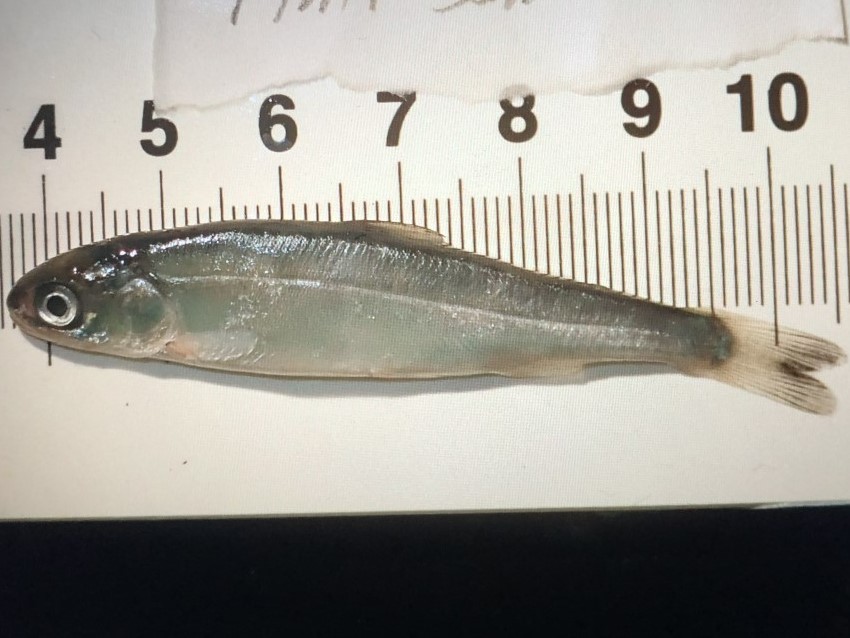Pacific salmon can now reproduce in Alaska’s Arctic, researchers find
A single juvenile fish found in a lagoon on Alaska's North Slope proved salmon can reproduce in the North American Arctic.

Waist-deep in the waters of Jago Lagoon off Alaska’s North Slope, biologist Vanessa von Biela and her research partners got a big surprise in the summer of 2017 when they were sorting through Arctic fish that had been captured in a test net. Among the hundreds of Arctic cisco in the net was a juvenile chum salmon — the first direct proof of successful salmon reproduction that far north in North America.
The young chum salmon, with its rounded nose, stood out among the masses of pointy-nosed Arctic cisco was quickly noticed by colleague Sean Burril, said von Biela, a research biologist with the U.S. Geological Survey.
“He happened to hold this one in his hand and he said, ‘Hey, this one feels different,’ and, ‘This one is a salmon,’” she said.
That one juvenile salmon found near the Inupiat village of Kaktovik during fieldwork to study Beaufort Sea fisheries represented a breakthrough — the product of an egg laid in the Arctic waters that survived the winter.
Details of the discovery and its significance are described in a new study published in the Canadian Journal of Fisheries and Aquatic Sciences, with von Biela and Burril, who is with the Bureau of Ocean Energy Management, as co-authors.
Plenty of salmon swim that far north, and plenty of those wind up spawning and depositing eggs in the gravel, von Biela said. But there had never been proof that any of that spawning had resulted in successful reproduction so far north in North America – until this single chum salmon swam into their net.
It was a rare find, said Karen Dunmall of Fisheries and Oceans Canada, the study’s lead author.
“It’s like there’s a needle in a haystack to find this one chum salmon,” she said.
However, there are likely more salmon hatching and developing in such Arctic waters, she said. It is just a matter of looking in the right places and finding them, she said.
With declines in sea ice and warming water temperatures, changes for salmon reproductive success in Arctic waters are increasing, she said. “It’s an indication of the broader-level changes that are going on in the environment,” she said.
There is much documentation of salmon moving north and pushing to new frontiers of their changing habitat. Pink salmon, a species with a life cycle of only two years, have demonstrated this “plasticity,” as shown by increasing numbers established in the northern Bering Sea and individuals have been found as far north as the waters off Nunavut in Canada. The changing conditions allowing northward movement of species like pink salmon and Pacific cod are also cited as examples of “borealization” of the Arctic.
For now, the Kotzebue Sound region along the Arctic Circle just north of the Bering Strait, where there is a longstanding commercial harvest, is the farthest-north Alaska site known for successful salmon reproduction. Chum salmon reproduction, in particular, has long been documented there.
But farther north, Pacific salmon are at a disadvantage compared to related fish like Arctic cisco and Dolly Varden, which spend winters in either brackish water or fresh water that is still flowing at sites like deep levels of lakes. It has been thought that Pacific salmon in the Arctic generally have to swim south through the Bering Strait into the Bering Sea to survive the winter, von Biela said.
But a different future may be in store for salmon in Arctic Alaska and Arctic Canada, as the single juvenile chum salmon caught off Kaktovik indicates.
That particular fish — which “gave its body to science,” as von Biela put it — was frozen before she sent it to Dunmall for further analysis. Dunmall used isotope analysis to get a clearer picture of the source of this one fish. Evidence points to this salmon having originated in Canada’s Mackenzie River — which is also the source of the Arctic cisco on Alaska’s North Slope — or a similarly situated freshwater site.
All that information contributes to Dunmall’s wider studies that are investigating salmon adaptations in the Arctic. Among the questions: How cold is too cold for salmon eggs and juveniles to survive? Generally, she said, salmon need temperatures no colder than 2 degrees to 4 degrees Celsius. But it could be that the Arctic salmon have adapted or are adapting to colder temperatures, she said.
Some preliminary findings show that salmon in the Arctic may behave differently than they do in the Pacific, she said. While Pacific salmon stop eating once they return to freshwater to spawn, those found in the Arctic appear to keep eating, she said.
On-site reports from Indigenous communities in the Canadian Arctic — which have proved essential to Dunmall’s research — include reports of salmon harvested in Arctic waters with food in their stomachs. There have even been salmon seen eating in those freshwaters while local people were harvesting them, she said.
It’s not yet clear whether salmon reproductive success in Arctic waters is a good thing. It could be good for people of the region to have a new source of food, or it could be bad if the salmon displace the more Arctic-specific fish populations, Dunmall and von Biela said.
“I think it depends on who you talk to,” Dunmall said. “It’s definitely something that’s happening.”